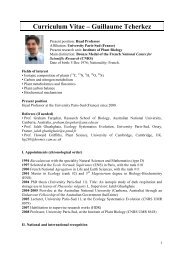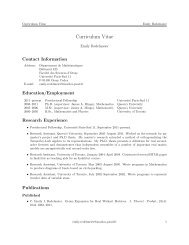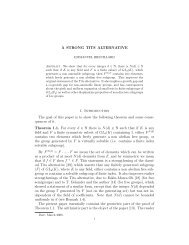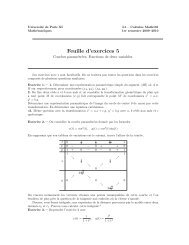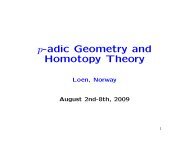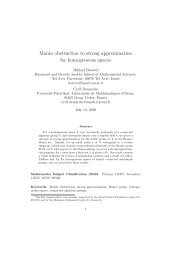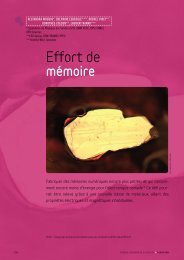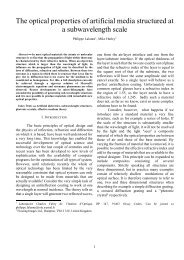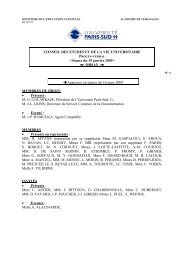Birational invariants, purity and the Gersten conjecture Lectures at ...
Birational invariants, purity and the Gersten conjecture Lectures at ...
Birational invariants, purity and the Gersten conjecture Lectures at ...
You also want an ePaper? Increase the reach of your titles
YUMPU automatically turns print PDFs into web optimized ePapers that Google loves.
24<br />
Proof : Suppose first th<strong>at</strong> k is a perfect field. Fix i. Let us prove th<strong>at</strong> <strong>the</strong> restriction map<br />
is surjective for c > (i+1)/2. The proof is by descending induction on <strong>the</strong> codimension of<br />
F in X, subject to <strong>the</strong> condition c > (i+1)/2. Assume it has been proved for c+1. There<br />
exists a closed subset F 1 ⊂ F of codimension <strong>at</strong> least c+1 in X such th<strong>at</strong> F −F 1 is regular,<br />
hence smooth over <strong>the</strong> perfect field k, <strong>and</strong> of pure codimension c in X −F 1 (<strong>the</strong> closed set<br />
F 1 is built out of <strong>the</strong> components of F of dimension strictly smaller than <strong>the</strong> dimension of<br />
F <strong>and</strong> of <strong>the</strong> singular locus of F ). From i + 1 − 2c < 0 <strong>and</strong> <strong>the</strong> <strong>the</strong>orem, we conclude th<strong>at</strong><br />
(X − F, µ⊗j n ) is surjective. The induction<br />
(X, µ⊗j n ) −→ Het í (X − F, µ⊗j n ) is<br />
surjective, hence Het í (X, µ⊗j n ) −→ Het í (X − F, µ⊗j n ) is surjective. Th<strong>at</strong> <strong>the</strong> restriction<br />
map is injective for c > i/2 is proved in a similar manner. The proof will be left to <strong>the</strong><br />
reader. For <strong>the</strong> induction to work we need to be over a perfect field, to ensure th<strong>at</strong> regular<br />
schemes are smooth. But since étale cohomology is invariant under purely inseparable<br />
extensions ([SGA4] VIII 1.1, [Mi80] Rem 3.17 p. 77), <strong>the</strong> corollary holds over all fields.<br />
<strong>the</strong> restriction map Het í (X − F 1, µ ⊗j<br />
n ) −→ Het í<br />
assumption now implies th<strong>at</strong> <strong>the</strong> restriction map Het í<br />
Let X be a smooth integral k-variety. For c = 1, Corollary 3.4.2 says th<strong>at</strong> for a<br />
nonempty open set U ⊂ X, <strong>the</strong> restriction maps on sections Hét 0 (X, µ⊗j n ) −→ Hét 0 (U, µ⊗j n )<br />
are isomorphisms, which is nearly obvious, <strong>and</strong> th<strong>at</strong> <strong>the</strong> maps Hét 1 (X, µ⊗j n ) −→<br />
Hét 1 (U, µ⊗j n ) are injective.<br />
For c = 2, Corollary 3.4.2 says th<strong>at</strong> if F is a closed subset of codimension <strong>at</strong> least 2, <strong>the</strong><br />
restriction maps Het í (X, µ⊗j n ) −→ Het í (X −F, µ⊗j n ) are injective for i ≤ 3 <strong>and</strong> bijective for<br />
i ≤ 2. Using <strong>purity</strong> for discrete valu<strong>at</strong>ion rings, commut<strong>at</strong>ivity of étale cohomology with<br />
direct limits ([Mi80], III 3.17 p. 119), <strong>and</strong> <strong>the</strong> Mayer-Vietoris sequence ([Mi80], III.2.24<br />
p. 110), from <strong>the</strong> result just proved one may deduce <strong>the</strong> existence of exact sequences<br />
(3.7) 0 −→ H 1 (X, µ ⊗j<br />
n ) −→ H 1 (k(X), µ ⊗j<br />
n ) −→ ⊕<br />
H 0 (k(x), µ n ⊗(j−1) )<br />
x∈X (1)<br />
<strong>and</strong><br />
(3.8) H 2 (X, µ ⊗j<br />
n ) −→ H 2 (k(X), µ ⊗j<br />
n ) −→ ⊕<br />
H 1 (k(x), µ n ⊗(j−1) ).<br />
x∈X (1)<br />
(A similar argument, with more details, will appear in <strong>the</strong> proof of Theorem 3.8.2 below.)<br />
From <strong>the</strong> Kummer sequence we get a functorial surjection H 2 (X, µ n ) → n Br(X) (see<br />
(3.2)). The map H 2 ét (X, µ n) −→ H 2 ét (X − F, µ n) is bijective by Corollary 3.4.2. Hence if<br />
X/k is a smooth integral variety over a field k of characteristic zero, <strong>and</strong> F is a closed<br />
subset of codimension <strong>at</strong> least 2, <strong>the</strong> restriction map Br(X) → Br(X −F ) is surjective. It<br />
is <strong>the</strong>refore an isomorphism, since over any regular integral scheme X, for any nonempty<br />
open set U, <strong>the</strong> restriction map Br(X) → Br(U) is injective ([GB II] 1.10). All in all, for<br />
X a smooth variety over a field k <strong>and</strong> char(k) = 0, <strong>the</strong>re is an exact sequence<br />
(3.9) 0 −→ Br(X) −→ Br(k(X)) −→ ⊕<br />
x∈X (1) H 1 (k(x), Q/Z).



